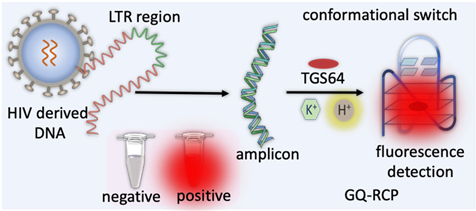Researchers have developed a technology for targeted better detection of HIV-genome derived G-Quadruplex (GQ), a four stranded unusual and characteristic DNA structure, using a fluorometric test, offering increased reliability of diagnosis. This diagnostic platform promises to significantly reduce false positives in HIV detection.
The human immunodeficiency virus type 1 (HIV-1), a retrovirus responsible for the acquired immunodeficiency syndrome (AIDS), remains a persistent global threat to human health. Widely used HIV diagnostics, may miss early infections and harbour risk of false positives due to cross-reactivity. Other clinical methods for early detection, are limited by reduced sensitivity and prolonged processing times, respectively. Current nucleic acid-based diagnostics are prone to false positives due to the use of general DNA sensing probes that fail to distinguish between nonspecific and target amplicons. In this context, the identification and targeting of specific nucleic acid sequences can significantly reduce false positives. Therefore, the development of molecular probes that selectively recognize unique nucleic acid structures such as unusual GQ structures in pathogenic genome, offers significant advancement for development of precise diagnostic assays.
A team of scientists at Jawaharlal Nehru Centre for Advanced Scientific Research (JNCASR), has developed a novel diagnostic technology known as the GQ Topology-Targeted Reliable Conformational Polymorphism (GQ-RCP) platform. Initially designed for the fluorometric detection of pathogens like SARS-CoV-2, this versatile platform has now been successfully adapted for diagnosing HIV, reiterating its modular versatility.
Sumon Pratihar, Vasudhar Bhat S V, Krithi K. Bhagavath, Thimmaiah Govindaraju, from JNCASR, an autonomous institution of Department of Science and Technology, demonstrated the GQ topology targeted reliable detection of HIV-derived GQ DNA through a method called reverse transcription and amplification of a 176-nucleotide long genomic segment.
A critical aspect of the study published in Analytical Chemistry was the demonstration of a pH-mediated, facile, single-step quantitative transition of dsDNA into the GQ conformation, which forms the target for detection with remarkable selectivity using a designed benzobisthiazole-based fluorescent probe (TGS64) and setting the stage for the establishment of a reliable diagnostic platform.
Unlike most other diagnostic assays developed in recent years, which rely on pre-existing principles for detection, this research introduces an entirely novel diagnostic platform based on specific and unusual nucleic acid–small molecule interactions identified during the course of the study.
This molecular detection platform can be integrated into existing nucleic acids based diagnostic platforms with increased reliability stemming from sequence specific recognition.
It could alleviate the challenge in existing amplification-based techniques, in discrimination of false-positive results arising from non-specific amplification and help achieve unambiguous detection of the target GQ (noncanonical nucleic acid conformation).
The GQ-RCP-based platform can be practically adopted for the detection of various DNA/RNA based pathogens including bacteria and viruses.
Publication link: https://doi.org/10.1021/acs.analchem.4c03374































